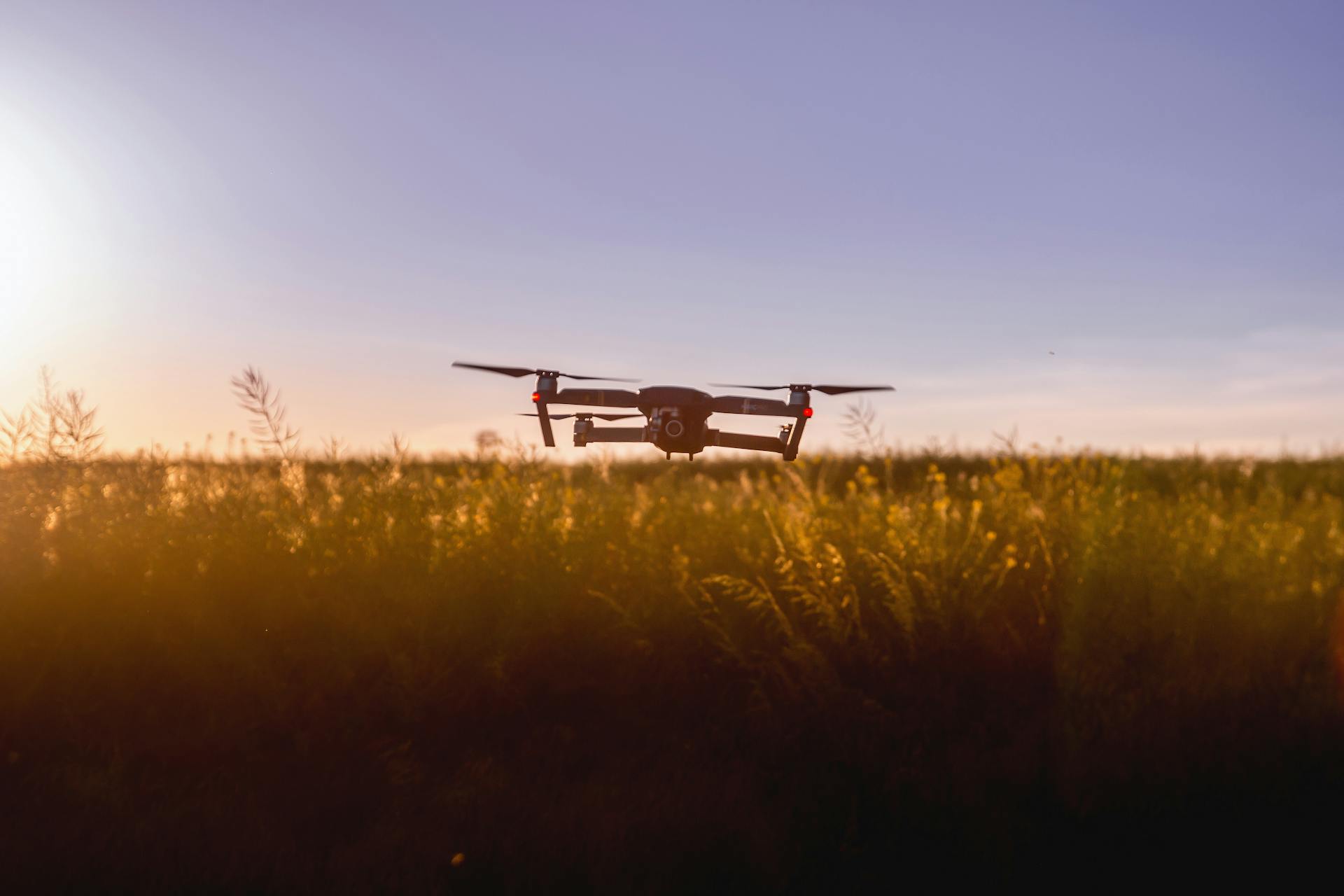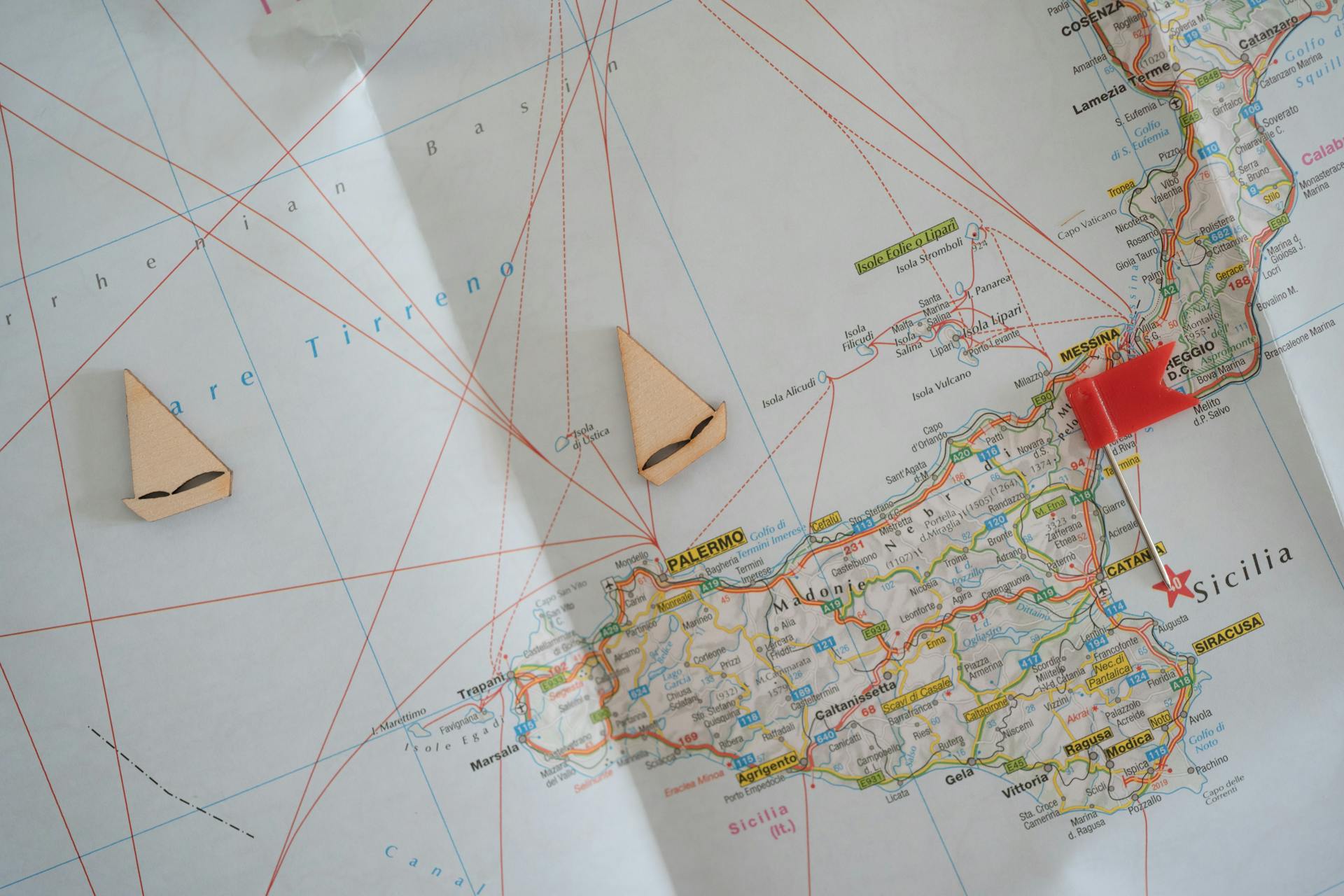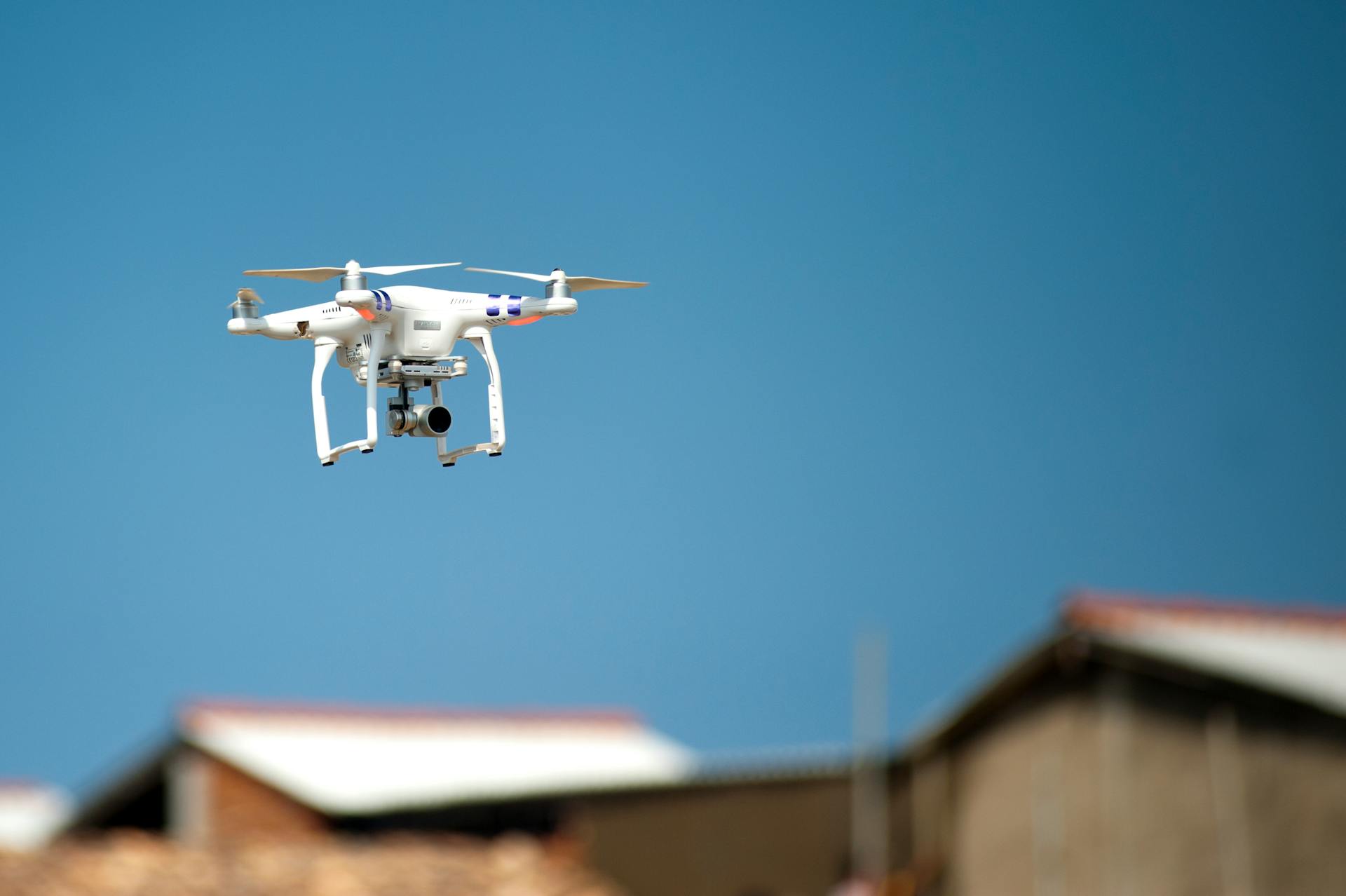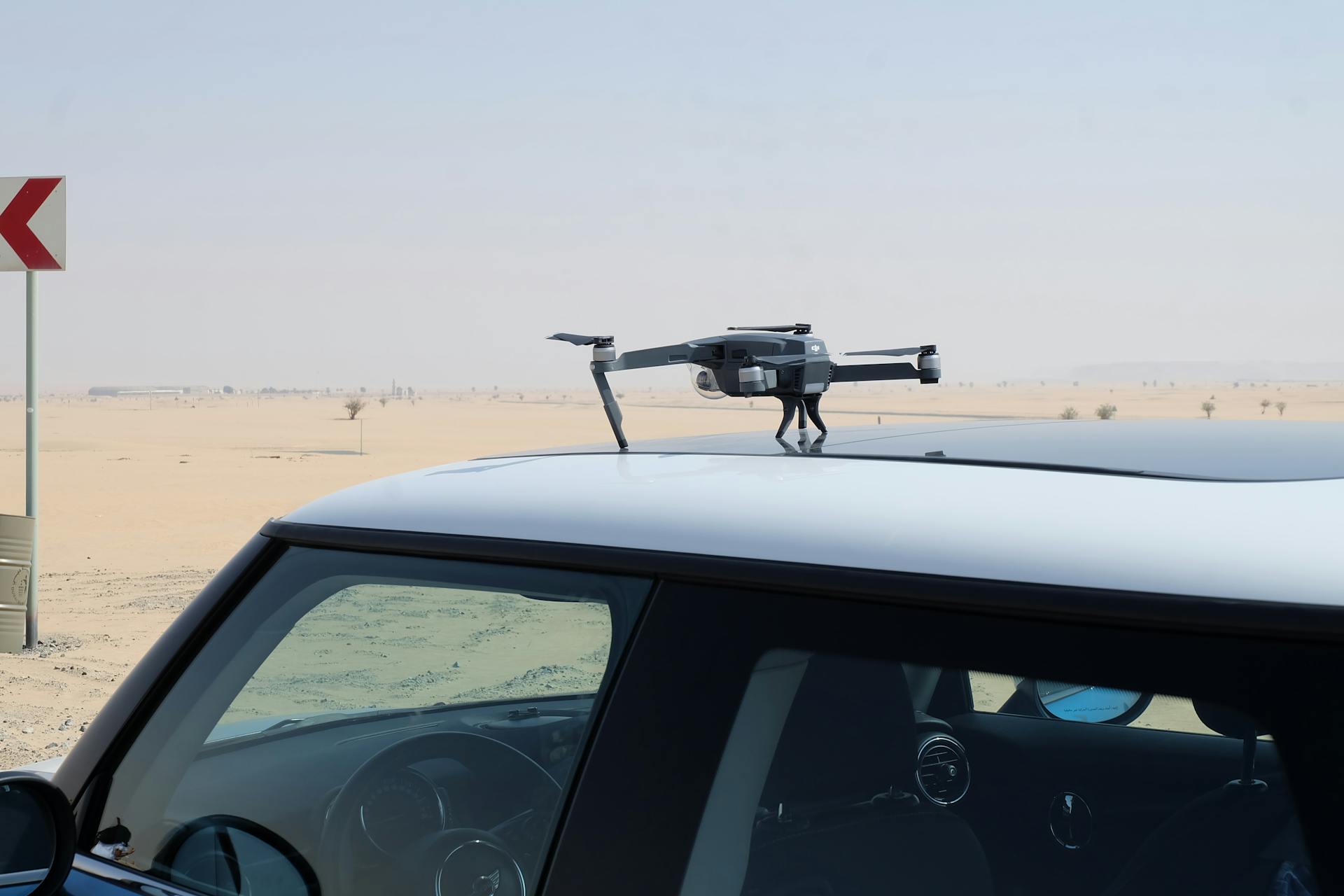
Open source UAV software is revolutionizing the way we fly drones and unmanned aerial systems.
PX4 is an open source flight stack that allows developers to create custom autopilot systems for their drones.
It's a highly customizable and scalable solution that can be used for a wide range of applications, from recreational flying to industrial inspection.
PX4 is compatible with a variety of hardware platforms, making it a versatile choice for developers.
ArduPilot is another popular open source UAV software that's been around since 2009.
It's designed for a wide range of vehicles, including fixed-wing, multirotor, and traditional helicopters.
ArduPilot's community-driven approach ensures that it stays up-to-date with the latest technology and advancements in the field.
You might enjoy: Uav Mapping Software
Software Features
ArduPilot provides a large set of features, including the following common for all vehicles: ArduPilot is fully documented within its wiki, totaling the equivalent of about 700 printed pages and divided in six top sections.
ArduPilot's documentation is extensive, with a "common" section regrouping information common to all vehicle types shared within the first four sections. This makes it easier for users to find the information they need.
ArduPilot can work on many different types of vehicles, including multirotors, fixed wing planes, land rovers, and even submarines. This versatility is a major advantage of the software.
Here are some key features of ArduPilot:
- Support for multiple vehicle types
- Extensive documentation
- Customizable and flexible
- Advanced control algorithms
Features
ArduPilot offers a wide range of features that make it a powerful tool for drone enthusiasts and professionals alike. The software suite is fully autonomous, semi-autonomous, and fully manual, allowing users to choose their preferred mode of operation.
One of the key features of ArduPilot is its ability to perform programmable missions with 3D waypoints, making it ideal for complex tasks such as search and rescue, surveying, and mapping.
The software also offers stabilization options, negating the need for a third-party co-pilot, and simulation capabilities with various simulators, including ArduPilot SITL.
ArduPilot supports a large number of navigation sensors, including RTK GPSs, traditional L1 GPSs, barometers, magnetometers, laser and sonar rangefinders, optical flow, ADS-B transponder, infrared, airspeed, sensors, and computer vision/motion capture devices.
Additionally, ArduPilot provides failsafes for loss of radio contact, GPS, and breaching a predefined boundary, ensuring the safety of the drone and its surroundings.
Here are some of the key features of ArduPilot:
- Fully autonomous, semi-autonomous, and fully manual flight modes
- Programmable missions with 3D waypoints
- Stabilization options for autonomous flight
- Simulation capabilities with various simulators
- Support for a wide range of navigation sensors
- Failsafes for loss of radio contact, GPS, and breaching a predefined boundary
- Support for navigation in GPS-denied environments
- Support for actuators such as parachutes and magnetic grippers
- Support for brushless and brushed motors
- Photographic and video gimbal support and integration
- Integration and communication with powerful secondary or "companion" computers
Data Page
The Data Page is a crucial part of the software, where you can access a live stream of the drone's telemetry and location.
Located at the top-right corner, a dropdown menu allows you to establish a connection with the UAS.
The HUD in the top-left region visualizes the current status of the UAV, displaying it as a typical airplane.
A quick access toolbar under the HUD gives you access to various features, including setting quick actions, viewing data logs, and inspecting gauges.
You can also view sensor readouts and statuses, as well as control servos for manually triggering sensors and cameras if configured.
Additionally, the toolbar provides extra telemetry, offering additional information reported from the drone.
Vehicle-Specific Features
Each vehicle type in ArduPilot has its unique features. For example, copters support a wide variety of frame types, including tricopters, quadcopters, hexacopters, and custom motor configurations.
Copters also offer a range of flight modes, including Stabilize, Alt Hold, Loiter, RTL, Auto, Acro, AutoTune, Brake, Circle, Drift, Guided, and more.
Here's a breakdown of the vehicle-specific features:
Each vehicle type has its unique capabilities, making ArduPilot a versatile open source UAV software solution.
Copter-Specific
The Copter-specific features of a vehicle are numerous and impressive.
One of the most exciting features is the variety of flight modes available, including Stabilize, Alt Hold, Loiter, RTL (Return-to-Launch), Auto, Acro, AutoTune, Brake, Circle, Drift, Guided, Guided_NoGPS, Land, PosHold, Sport, Throw, Follow Me, Simple, Super Simple, and Avoid_ADSB.
The vehicle also supports a wide range of frame types, including tricopters, quadcopters, hexacopters, flat and co-axial octocopters, and custom motor configurations.
If you're looking to fly a traditional electric or gas helicopter, or even a mono copter or tandem helicopter, you're in luck - this vehicle has got you covered.
Here are some of the supported copter types:
- Tricopters
- Quadcopters
- Hexacopters
- Flat and co-axial octocopters
- Custom motor configurations
- Traditional electric and gas helicopters
- Monocopters
- Tandem helicopters
Plane-Specific
In the world of flight simulation, having plane-specific features can make all the difference. This is especially true for those who want to experience the thrill of flying a variety of aircraft.

The plane-specific features in this software are quite impressive, with options like Fly By Wire modes, loiter, auto, and acrobatic modes available for a range of planes. These modes allow for a more realistic and immersive experience.
For take-off, you can choose from hand launch, bungee, catapult, or vertical transition (for VTOL planes) options. This gives you the flexibility to simulate different scenarios and environments.
Landing options are also highly customizable, with adjustable glide slope, helical, reverse thrust, net, and vertical transition (for VTOL planes) available. This ensures a safe and controlled descent every time.
The software also supports auto-tuning, simulation with JSBSIM, X-Plane, and RealFlight simulators, making it easy to fine-tune your flying skills.
Rover-Specific
Rover-Specific features are a game-changer for any vehicle operation.
Rovers have a variety of operational modes to choose from, including Manual, Learning, Auto, Steering, Hold, and Guided.
These modes cater to different driving scenarios and preferences, allowing users to tailor their experience.
One notable aspect of rover-specific features is the support for both wheeled and track architectures.
This versatility makes rovers suitable for a wide range of environments and applications.
Use Cases and Applications
Open source UAV software has numerous practical applications.
It can be used for surveillance, such as monitoring crops for signs of disease or pests.
The software can also be used for search and rescue operations, helping emergency responders locate missing people.
For example, the Pixhawk autopilot system can be used to stabilize and control UAVs in challenging weather conditions.
Additionally, open source UAV software can be used for mapping and surveying, creating detailed models of terrain and infrastructure.
Best Drone Projects
Here's a drone project that's a great example of using drones for inspection: the inspection of wind turbines, which can be done with a drone equipped with a high-resolution camera and thermal imaging sensor. This can help identify potential issues before they become major problems.
Drones can be used to monitor and inspect large areas, such as construction sites or agricultural fields, with a drone equipped with a multispectral camera. This can help farmers identify areas where crops may be struggling and provide more targeted support.
On a similar theme: Turkish Uav Drones
Inspecting hard-to-reach areas, such as bridges or buildings, is another key use case for drones, often done with a drone equipped with a high-resolution camera and GPS. This can help engineers identify potential issues before they become major problems.
Drones can also be used to create 3D models of areas, such as buildings or landscapes, with a drone equipped with a high-resolution camera and photogrammetry software. This can help architects and urban planners design and develop new projects more efficiently.
You might enjoy: High Altitude Long Endurance Uav
ArduPilot Use Cases
ArduPilot is a popular drone autopilot software that has been around since the beginning and has an active development community. It's used in a wide range of applications, from fixed-wing planes to multirotors and even submarines.
ArduPilot is capable of full autonomous flight, making it a great choice for those who want to fly their drones without any human intervention. It's also used in commercial systems, and has a large developer community that contributes to its growth.
One of the key features of ArduPilot is its ability to work on many different types of vehicles, including multirotors, fixed-wing planes, land rovers, and even submarines. It's also compatible with a diverse collection of flight controller boards.
ArduPilot is an open-source project, which means that anyone can contribute to its development and use it for free. However, this also means that any changes made to the codebase need to be added back to the parent project, which can be a con for businesses that want to protect their IP.
Here are some of the key use cases for ArduPilot:
- Autonomous flight
- Commercial systems
- Multirotors
- Fixed-wing planes
- Land rovers
- Submarines
ArduPilot has been used in several high-profile competitions, including the UAV Outback Challenge, where it won first place in 2012, 2014, and 2016. Its advanced control algorithms and wide range of supported hardware make it a popular choice among drone enthusiasts and professionals alike.
In addition to its use in autonomous flight, ArduPilot can also be used for FPV flying and racing. However, it's worth noting that it's not the best choice for FPV drone racing, as it's more geared towards autonomous flight.
Take a look at this: Uav Flight Planning Software
FPV and Racing
FPV and racing projects are a great way to push the limits of your drone's performance. They're specifically designed to help you squeeze every last bit of speed and agility out of your aircraft.
FPV and racing projects often have modes and features dedicated to optimizing motor performance. This means you can expect to see improvements in your drone's responsiveness and overall flying experience.
Betaflight project homepage is a great resource for learning more about FPV and racing projects. It's a comprehensive platform that offers a wealth of information and tools for pilots.
Cleanflight project homepage is another excellent resource for those interested in FPV and racing projects. It's a dedicated platform that provides a range of features and tools for pilots to fine-tune their aircraft.
MultiWii github page is a great place to start if you're looking to get involved in the development of open source UAV software. It's a community-driven platform that allows developers to collaborate and share their work.
Here are some popular open source FPV and racing projects:
- Betaflight
- Cleanflight
- MultiWii
Installation and Setup
To install Mission Planner, download the installer file from https://ardupilot.org/planner/docs/mission-planner-installation.html, or find it at https://ardupilot.org if the link doesn't work.
Mission Planner requires a computer running Windows or Linux with Mono, but this guide will assume a user is running Windows.
Upon installation, you may be asked to enable Altitude Angel airspace management data, which can be safely ignored.
The program and all necessary files should be present and ready to explore after installation.
The “Setup” page enables the setting of key features such as firmware, configurations for radios, gimbals, and other optional add-on hardware.
These settings are not likely to be revisited once set, so it's essential to get them right from the start.
For the purposes of this guide, the visuals and processes are gathered from version 1.3.75 build 1.3.7883.26333 of Mission Planner.
A different take: Dji Inspire 1 Uav
Simulation Page
The Simulation Page is where you get to test and refine your flight plan in a realistic way. This page allows you to simulate the flight of your UAV in real-life conditions.
You can choose from two common types of UAVs: fixed-wing or multi-rotors. The simulation shows you what the flight would look like, giving you a chance to make adjustments before actually flying.
The Simulation Page is a crucial part of the open source UAV software, giving you the tools you need to validate and adjust your flight plan as needed.
Featured Images: pexels.com


